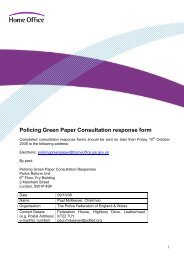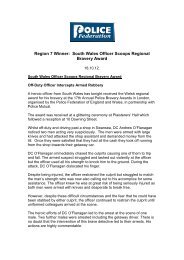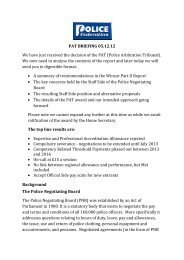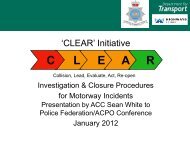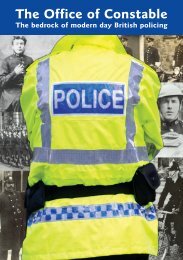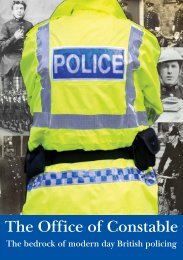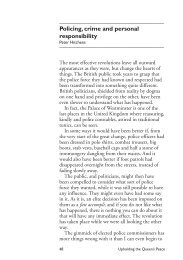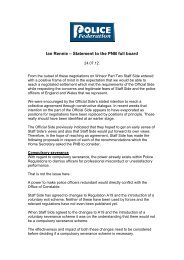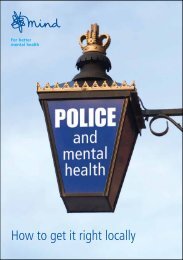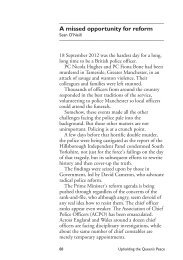Policing UK 2013 - Police Federation
Policing UK 2013 - Police Federation
Policing UK 2013 - Police Federation
Create successful ePaper yourself
Turn your PDF publications into a flip-book with our unique Google optimized e-Paper software.
POLICING CHALLENGES<br />
“The <strong>UK</strong> and other Western nations had<br />
been slow to read the signs throughout the<br />
1990s as radical Islamist-inspired terrorism<br />
began to wreak havoc around the world.”<br />
weeks, approval for over £60 million of<br />
additional in year expenditure saw the<br />
beginning of a lasting change in the way<br />
the <strong>UK</strong> counter terrorism machinery is<br />
configured and operates.<br />
At this time, <strong>UK</strong> counter terrorism<br />
remained very much geared to deal with<br />
a domestic extremist threat, mainly from<br />
Irish republican terrorist groups. Although<br />
the Good Friday Agreement had been<br />
signed in Belfast some 30 months earlier<br />
on 10 April 1998, the peace process was<br />
still in its infancy and the <strong>UK</strong> had not<br />
been motivated towards a reorientation<br />
of its counter terrorism philosophy in the<br />
light of the emerging new threat from<br />
international Islamist-inspired terrorism.<br />
A growing threat<br />
Looking back, these initial steps were<br />
but a drop in the ocean and a full<br />
appreciation of what needed to be done<br />
had not yet developed. However, this<br />
began to change as the <strong>UK</strong> and its allies<br />
‘retuned’ its intelligence radar into the<br />
Islamist threat. Within a year we saw the<br />
beginning of a period where the <strong>UK</strong><br />
would discover wave after wave of serious<br />
and credible attacks were being planned.<br />
This period (2002 -2009) marked the<br />
time when the <strong>UK</strong> fundamentally<br />
re-engineered its counter terrorism<br />
capability to one which is admired and<br />
emulated around the world.<br />
The so-called ‘Ricin poisoning plot’ of<br />
2002 led to a police operation in which<br />
four officers were stabbed, one fatally, by<br />
a terrorist suspect. He was later convicted<br />
of the murder of a police officer and of<br />
terrorism offences based on evidence<br />
indicating he was in the early stages of<br />
planning a bioterrorism attack on the<br />
London underground system.<br />
In 2004 another conspiracy was<br />
uncovered, colloquially named the ‘Gas<br />
– Limousine’ plot where evidence was<br />
uncovered of a developing plan to use gas<br />
canister-filled stretch limousines to attack<br />
economic key sites in New York and<br />
potentially London.<br />
That same year ‘Operation Crevice’<br />
revealed a large network of mainly <strong>UK</strong>based<br />
extremists who had procured half<br />
a ton of ammonium nitrate and were<br />
planning a fertiliser-based lorry bomb<br />
attack. Potential targets included the<br />
Bluewater shopping centre in Kent.<br />
These operations resulted in numerous<br />
arrests and subsequent convictions. These<br />
were just some of the most high-profile<br />
terrorism investigations at the time,<br />
behind the scenes the strengthening<br />
intelligence machinery was beginning<br />
to identify other individuals and groups<br />
in the <strong>UK</strong> who were apparently intent<br />
on encouraging, inciting, supporting or<br />
participating in attacks in the <strong>UK</strong> or<br />
against our interests overseas or our allies.<br />
A number of other security service<br />
and police operations had disrupted or<br />
otherwise prevented terrorist attacks in<br />
circumstances where it was not possible<br />
to bring a criminal case before the courts.<br />
To this day not all aspects of the threats<br />
identified can be made public but in<br />
2007 the Director General of the British<br />
Security Service MI5 made reference in<br />
a speech to “over 2,000 people in the <strong>UK</strong><br />
who posed a threat to national security,”<br />
and indicated the number was increasing.<br />
Major escalation<br />
In July 2005, the murderous attacks on<br />
the London transport system brought<br />
home the cold reality, that despite<br />
enormous efforts to strengthen the <strong>UK</strong><br />
counter terrorism machinery, the threat<br />
was growing and attacks were now getting<br />
through and innocent lives were being<br />
lost. The use of suicide bomb tactics in<br />
the <strong>UK</strong> added to the sense of urgency<br />
that more needed to be done.<br />
This marked a major escalation in<br />
the response with new anti-terror laws<br />
being passed which created new offences<br />
aimed at those who encouraged, incited<br />
and supported terrorism and introduced<br />
measures such as ‘control orders’<br />
(now revised and renamed as terrorist,<br />
prevention and investigation measures<br />
(TPIMs)). These restricted the movements<br />
and activities of those in respect of whom<br />
secret intelligences sources revealed an<br />
overwhelming case that they were a threat<br />
to national security but against whom it<br />
was not possible to bring a prosecution<br />
due to technical evidential issues or<br />
without compromising sources or covert<br />
methods to the wider detriment of <strong>UK</strong><br />
national security.<br />
Developing the National Counter<br />
Terrorism Network<br />
New and much greater investments were<br />
now authorised by government to further<br />
develop capability. In this period the<br />
police and the security service began to<br />
develop the concept of what we call today<br />
the National Counter Terrorism Network,<br />
an integrated police and security service<br />
capability with joint regional operational<br />
and intelligence hubs throughout the<br />
country.<br />
As this network developed, both the<br />
security service and the police were able to<br />
double the number of personnel working<br />
directly within the counter terrorism<br />
capability. Fully operational Counter<br />
Terrorism Units were established in three<br />
POLICING <strong>UK</strong> | 89



